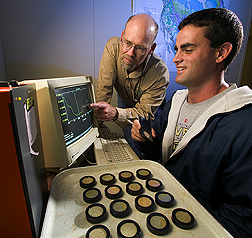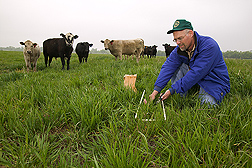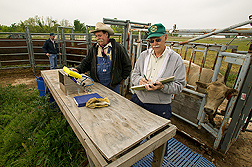Filling the Southern Plains Forage Gap
New Grasses May Solve Feeding Dilemma
|
|
For much of the year, the southern Great Plains provides livestock producers with an abundance of forage—be it winter wheat or warm-season grasses—for putting valuable weight on their stocker calves.
But problems arise during April and May, and again from September to November, when the region doesn’t produce enough quality forage to provide good animal weight gain.
These “forage gaps” wreak havoc with livestock managers’ planning and bottom lines, often making them use costly feed supplements so their cattle can continue to gain weight.
Finding ways to efficiently fill these gaps is a primary mission at ARS’s Grazinglands Research Laboratory in El Reno, Oklahoma. Two researchers there, ecologist Brian Northup and animal scientist William Phillips, believe introduced perennial cool-season grasses may help solve this dilemma.
“Putting weight on yearling stocker cattle with forage is a vital agricultural and economic activity here,” says Northup. “The region is part of a system for fattening cattle that has evolved over the past 60 years. It relies primarily on two types of forage: annual cool-season grass, such as winter wheat (Triticum aestivum), for grazing in fall through spring, and perennial warm-season grasses—such as native rangelands or the introduced Old World bluestems or bermudagrasses—for summer grazing.”
|
|
Both Northup and Phillips believe that perennial cool-season grasses could help fill these gaps because they have longer growing seasons than wheat and thus allow calves to sustain high daily gains throughout fall and spring. Says Phillips, “That can be the difference between a producer selling his cattle in a seller’s market or in a buyer’s market.”
The researchers add that a rotation including these perennial grasses and winter wheat may also lower risks associated with traditional all-wheat systems for producing pasture for stocker calves. “With wheat, planting date and precipitation are among the important variables influencing fall forage production,” says Northup. “Perennial cool-season grasses don’t have to be established annually.”
6 Million Calves A Year!
Each year, more than 6 million beef calves are transported to the southern Great Plains from other parts of the country to be grazed on nutritious winter wheat pastures. Having no forage gap would mean that even more cattle could be economically grazed in the area, or that grazing livestock could be retained longer.
In their search for gap fillers for the southern plains, Northup and Phillips have focused on three cool-season grasses not normally used in the area but often used as forage elsewhere.
|
|
These include Lincoln smooth brome (Bromus inermis), which is used extensively in northern Great Plains states such as Iowa and Nebraska, and Jose tall wheatgrass (Thinopyrum ponticum), which was developed in southern Australia and has been used in intermountain regions such as Utah and eastern Oregon. The scientists also studied Manska intermediate wheatgrass (Thinopyrum intermedium), which is used as forage in the Dakotas.
“These grasses vary in their persistence under both grazing and the hot, dry conditions that occur during summer in the southern plains,” says Northup. “Our aim is to develop management strategies to help the farmer survive and be productive in this region. This requires developing guidelines for proper fertilization and timing and the right amount of grazing.”
A Financial Challenge
Northup says the hard part of using these grasses is the economic impact of getting them started. He explains that all perennial cool-season grasses require an initial 1-year establishment period with no grazing. “This ensures a healthy stand but presents an economic hurdle from lost income that year,” says Northup.
In their studies, Northup and Phillips found that, when wheat fields were converted to perennial pasture, deferred income from not grazing represented 49 percent of total establishment costs.
“Yes, establishment costs in our experiments were high,” says Phillips. “And there were risks. For example, a dry fall following planting of the grasses could have led to a total loss. But a grower can make it pay off by spreading the upfront costs throughout the lifespan of the pasture, which we hope will be 7 to 10 years.”
“Also,” adds Northup, “if growing conditions during the establishment year are reasonable, a hay crop can be harvested from the perennial pasture in late summer to remove standing forage and prepare the pasture for fall grazing. This presents an opportunity to partially recover some of the lost revenue.”
Phillips says studies at El Reno begun in 2001 have shown that the cool-season grasses have lowered the cost of beef production by 18 percent on a cost-per-pound-of-gain basis.
He adds that the grasses extended the grazing of cool-season forages from between 165 and 180 days to roughly 240 days. “The daily gain isn’t as good as with wheat,” says Phillips. “And we don’t think we will ever totally replace wheat as forage. Wheat is flexible and adaptable, and you can quickly increase the number of acres you plant.
“But the longer season for the perennial grasses allows for similar results,” he continues, “and it allows producers to start grazing their cattle earlier, turn them around sooner, and get them to market faster, perhaps helping them catch a better market.”
Phillips says the ARS studies have stoked confidence in these grasses as an effective component of a modified forage system for stocker calf production in the southern Great Plains. “Despite drier-than-normal conditions, perennial cool-season grasses have persisted for 4 years and have worked well as a complementary forage to winter wheat for stocker production.”
“Also,” he adds, “the longer spring grazing season would allow calves to be marketed a month later, avoiding the seasonal glut of stocker calves entering the market from wheat pasture in late April and early May.”
The scientists envision combining these grasses with other forage resources to eventually create a 10- or 11-month grazing cycle and to produce grass-finished beef with little or no grain feeding.—By Luis Pons, Agricultural Research Service Information Staff.
This research is part of Rangeland, Pasture, and Forages, an ARS National Program (#205) described on the World Wide Web at www.nps.ars.usda.gov.
Brian K. Northup and William A. Phillips are with the USDA-ARS Grazinglands Research Laboratory, 7207 W. Cheyenne St., El Reno, OK 73036; phone (405) 262-5291, fax (405) 262-0133.
"Filling the Southern Plains Forage Gap" was published in the December 2005 issue of Agricultural Research magazine.









